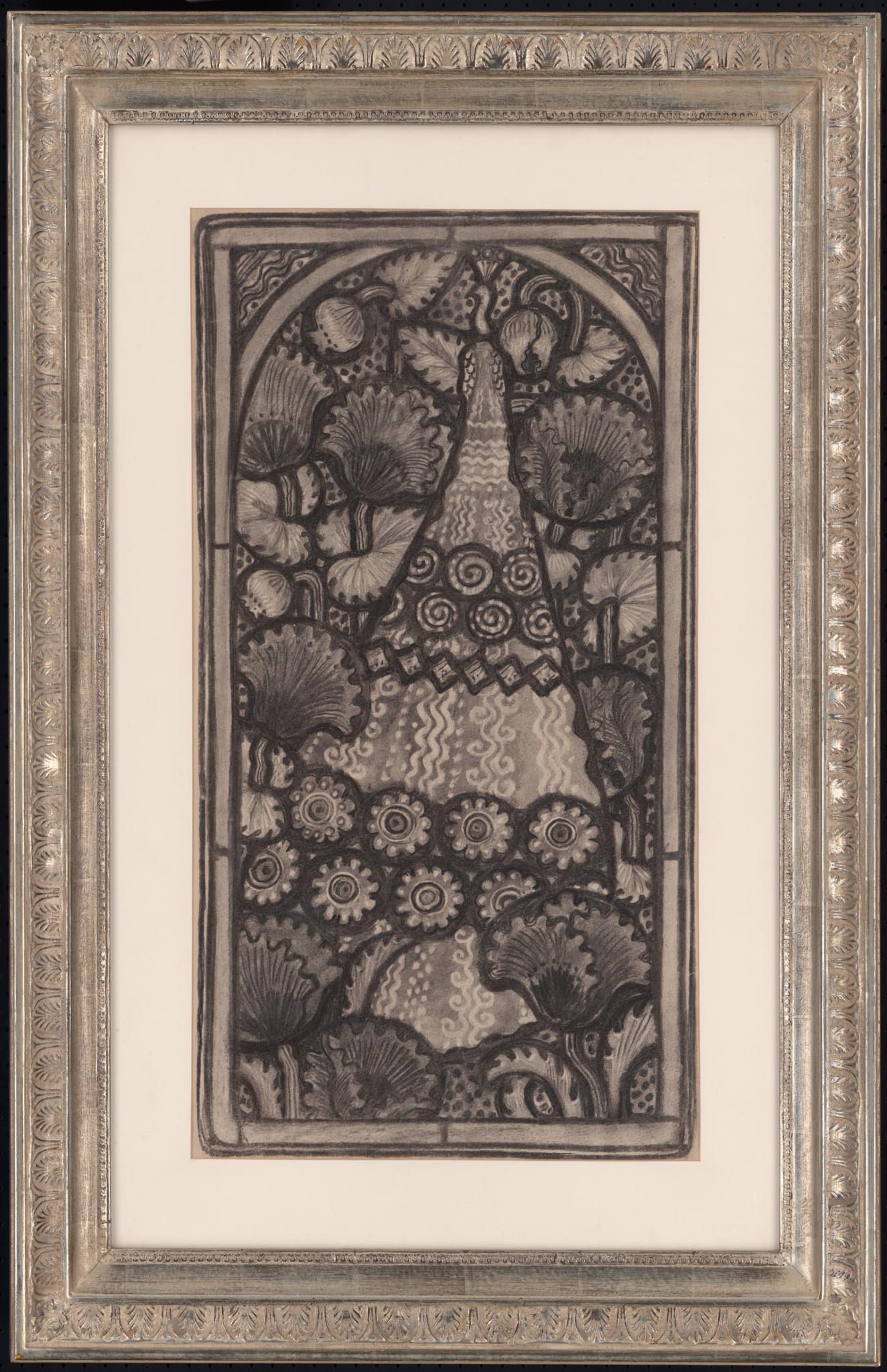Ce projet pour un vitrail a certainement été dessiné entre 1897 et 1901, alors qu’Augusto Giacometti (1877–1947) se trouvait à Paris pour suivre l’enseignement d’Eugène Grasset à l’Ecole normale d’enseignement du dessin, aussi appelée Ecole Guérin (Kaiser, 1999, p. 6-9). C’est dans ce contexte que Giacometti réalise ses premiers projets pour des vitraux. Dans ses mémoires, l’artiste déclare: “Wir hatten ja in Paris, im Unterricht bei Grasset, das Technische der Glasmalerei kennengelernt. Auch hatten wir in seinem Unterricht Aufgaben von ihm erhalten, kleinere Entwürfe für Glasscheiben zu machen” (Giacometti, 1997, p. 82). Grasset aimait en effet confronter ses élèves à l’application pratique de ses règles de composition ornementale. Le jeune artiste, originaire des Grisons, était un élève apprécié de Grasset, qui lui confia d’ailleurs la réalisation de la page titre de la seconde édition de son livre “La plante et ses applications ornementales, publié sous la direction de E. Grasset, 2e série” (1899) (Stutzer, 1991, p. 23). La première édition de cet ouvrage, parue en 1896-97, avait tellement impressionné Giacometti qu’il voulut rencontrer son auteur, ce qui a motivé son voyage à Paris.
Le motif du paon est très apprécié à l’époque de l’Art Nouveau et constitue souvent le motif principal d’une œuvre. Dans le vitrail “La Musique”, destiné à l’intérieur d’une maison privée et réalisé en 1900-1901 par l’atelier Gaudin d’après un projet d’Eugène Grasset, le paon est relégué discrètement à l’avant-plan (Murray-Robertson, 1981, p. 70). Cet oiseau se prête à merveille à l’application des théories ornementales d’Eugène Grasset, comme en témoigne trois études de l’artiste classées dans ses “Notes de cours sur les animaux” (Lepdor, 2011, p. 206). Augusto Giacometti a certainement suivi ce cours et il est permis de supposer que le projet conservé au Vitromusée est une application directe de l’enseignement d’Eugène Grasset. Dans un carnet d’esquisses de l’artiste grison se trouve une étude, datée du 10 décembre 1897, représentant deux paons dont les plumes sont insérées de manière ornementale une fois dans un carré, la seconde fois dans un rectangle (Stutzer, 1991, ill. 19, p. 21), reprenant de manière évidente la recherche de Grasset dans les trois études citées plus haut. Dans ce projet de vitrail, le paon se fond dans son environnement, et toute la surface, dans une sorte d’horror vacui, traite une variation d’ornements géométriques, palmettes, rosettes, spirales, motifs que l’on retrouve en 1905 dans l’ouvrage “Méthode de composition ornementale par Eugène Grasset”, publié à Paris en deux tomes. Une étude au pastel et à la craie, datant probablement de la même époque et mise aux enchères par la Maison Koller à Zurich le 2 décembre 2016 (Lot 3120, Z41 Art Suisse, voir Koller Auktionen, 2016), présente des similitudes évidentes et célèbre également le caractère hautement ornemental du sujet.
Les signes distinctifs d’un projet de vitrail sont clairement présents dans le dessin conservé au Vitromusée Romont: le tracé des plombs est bien défini et un filet d’encadrement est prévu. On ignore si un vitrail a été exécuté à partir de cette maquette, et si tel était le cas, sa localisation n’est à ce jour pas connue. Dans ses mémoires, Augusto Giacometti évoque l’existence de vitraux réalisés à Paris d’après ses projets, mais lui-même en ignore l’emplacement, ayant quitter la ville avant leur exécution (Giacometti, 1997, p. 50; Kaiser, 1999, p. 76). Grâce à l’étude des registres de l’atelier Gaudin, Jean-François Luneau a pu localiser ces vitraux: quatre verrières pour l’église Saint-Honoré-d’Eylau posées en 1902 (Luneau, 2006, p. 392). Ces quatre vitraux parisiens, où l’influence de l’enseignement de Grasset se manifeste par l’intérêt pour l’ornemental, se distinguent stylistiquement et surtout techniquement des vitraux ultérieurs de Giacometti, pour lesquels l’artiste s’impliquera beaucoup au stade de la réalisation en collaborant intensément avec l’atelier. Ce projet de vitrail avec le paon, peut-être le premier de l’artiste, se démarque aussi de ceux qu’Augusto Giacometti réalisera par la suite: exécutés en majorité au pastel coloré sur un papier noir ou foncé, le tracé du plomb y sera absent, l’artiste se concentrant à ce stade sur l’effet de couleurs (Kaiser, 1999, p. 46 et 49).
